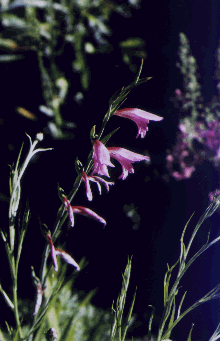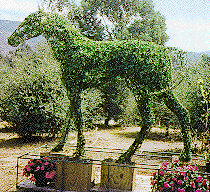The Website for St George’s Church, Waterlooville and its Parish Magazine St George’s News

According to my dictionary the word potpourri — or even pot-pourri — can be used to describe a medley of musical or literary items. I have heard it used as a collection of practically anything. Possibly it could be used to describe a collection of ‘Did you Know...’s.
By the way, do you know why churchyards so often harbour ancient yew trees? The actual reason why has been a subject of debate for many years. Some say they were planted to provide longbows for compulsory medieval archery practice, in which case they must have been planted by people who knew the king was going to insist on it. Others say that the trees were already growing on sites sacred to the Druids which were later taken over by Christian churches. There is also a rumour that the yew is a certain shield against ghosts and evil spirits, which gives a reason why yews should be planted all over the place. On a more mercenary note, it has been claimed that yews were placed in churchyards to persuade local farmers to pay for walls round the churchyard — yew leaves and berries are poisonous to cattle, and walls, while defining the church boundary, would also keep out any cattle tempted to nip in for a quick lunch. I leave it to you to choose which reason seems the most plausible.
And talking of longbows, did you know that the gladiolus is named after a sword. It’s a fact. It gets its name from the similarity of its leaves to the gladius, the sword of the Romans and weapon of the gladiator. In those days the southern Europeans were familiar only with the wild species of gladiolus that is native to Mediterranean countries. The larger, showier species which originated in South Africa were first brought to northern Europe not much more than 250 years ago. They were hybridised by the British and Belgians, and this gave rise to many of the brilliant, large-flowered, modern varieties that have been popular for so long. However, the smaller more natural looking varieties, such as Gladiolus byzantinus, which originally came from Asia Minor, are hardy (in fact they can be left undisturbed in the ground through the winter) and are easier to grow.
Whenever I hear the words ‘Did you know that...’ I cringe. I know that somebody is going to tell me some perfectly useless information — something that is irrelevant to the present topic of conversation. Something that I am probably not interested in and don’t really want to know. Something that I shall probably forget within five minutes.
By the way, did you know that, literally translated from the French, the word ‘potpourri’, that word we use to describe the sweet-smelling mixture that we use to improve the atmosphere in our rooms, means a ‘rotten’ or ‘putrid’ pot. It refers not to the floral content itself, of course, but to the effect on petals of the salt used in the drying process which turns them into a brown, rotting mess before they dry out and mature. Potpourris have been used for centuries. A form of potpourri was used in Biblical times, when desert dwellers used to place bags of aromatic herbs in their beds and clothes to make them sweet-smelling. This practice continued right into the Middle Ages when spices and flowers were dried and strewn on floors to reduce the noxious odours that were an inescapable part of living in those days. Today, any number of wonderfully perfumed potpourris can be produced including lavender and roses, fruits and berries, spring flowers and leaves, spices and the scents of conifers — making them suitable for any room in the home.


And talking of Romans, did you know that topiary was introduced into England by the conquering Romans - the word is derived from the Latin topiarus, 'fancy work'. But it did not become a passion for British gardeners until the 16th century, and then it remained popular for over 200 years, reaching its peak during the reign of William and Mary (1689-1702). But even during its golden age, this living form of sculpture was not without its critics ˜ Francis Bacon commented that 'images cut out in juniper or other garden stuff be for children'. Much topiary work was grubbed up in the 18th century when the trend moved towards natural landscapes, but by the end of the century the pendulum had swung back again. Today a new interest has grown up; you can even buy ready made topiary at a garden centre - at a price. And now, amateur as well as professional gardeners are indulging in this green art form.
And talking of topiary reminds me of something I once heard about hedging, especially the low hedges used in knot gardens which were so popular during the time of Elizabeth I. Did you know that to overcome the difficulty of planting a hedge so that it followed a pattern exactly, they used a piece of rope, a pot of honey and some suitable seeds. They mixed the seeds in the honey which was then smeared on the rope. All they had to do then was bury the rope in the desired pattern and, hey presto, a hedge appeared in exactly the right place. How's that for ingenuity.
And talking about the Elizabethan period, did you know that Mary Queen of Scots vowed that sheets woven from fibres obtained from stinging nettles were the smoothest she had ever slept in. Fishing nets and ropes were also spun out of the fibres. A green dye was obtained from the leaves, which were also brewed to make tea and beer. Medicinal uses of the plant were legion. Early recognition of the nettle's iron content led to it being prescribed for blood disorders, and nettle ale was said to be good for jaundice. Only, however, if the leaves were picked before May Day. After that, the Devil required them as raw material for his shirts. And it is said that rheumatism is relieved if the affected part is beaten with bunches of nettles: they would certainly make an effective counter-irritant and take your mind off the rheumatism.
And did you know that I could go on a long time yet passing on more of these bits of useless information? You must have guessed it by now. So I shall stop.
Happy Gardening.
Bill Hutchings
This series is taken from the St George’s News archives, and was first published in the Christmas issue 1997.






